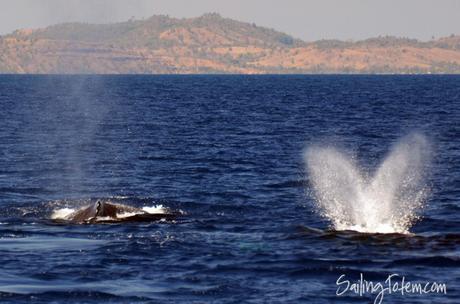
Madagascar is full of experiences that that impress upon us just how unique this land is. This is about the wildlife, of course: that something like 90% of flora and fauna are endemic, that is, they are unique to Madagascar. But it’s also about the everyday life of people we encounter, and how different that is from what we know.

Most of our time in Madagascar has been in the company with an old college friend of mine, who started an extended round-the-world walkabout with a couple of weeks on Totem. We hadn’t seen each other in years, which didn’t matter at all: he is the kind of friend in life who steps as easily in as if we’d had coffee last week.

As all visitors to Totem do, JP brought a bag of goodies with him (he was warned when we made plans to get a thrift shop duffle bag and expect to max the weight limit with our shopping list!). Boat parts of course: an inverter and some zincs. New shoes (you can only get so far on cheap flip flops). A replacement GoPro for friends. Books for the kids. He also brought a treasure trove of thoughtful gifts, including one we hadn’t remotely considered: JP speaks fluent French.
Madagascar is a polyglot country: most kids grow up speaking a dialect that’s a derivative of Malagasy (but specific to one or another of the 18 tribes in Madagascar), have instruction in Malagasy at school, and learn French – the colonial legacy – as a second language. It’s not easy to find an English speaker.

We headed back to Nosy Mitsio from the bustle in Nosy Be Mitsio, looking for some quiet and new experiences. It’s humpback migration season, and we passed several pods along the way.

Within a short time of settling in at anchor inside the deep vee of a bay, a dugout with two visitors came out. We’d probably have managed trading with our mix of pantomime and phrasebook French, but JP not only makes it easier- his skill means we get to know Sharaf a little better, while we trading a collection of clothes and household goods (some needles and thread) for some lobsters.
Sharaf came back to Totem the next morning while French toast was flying off the stove, with a handful of shark’s teeth and a dozen or so limes to trade. We took the opportunity to add a plate for him at the table and with JP’s help, learn more about his home. It’s still imperfect, because Sharaf’s French actually isn’t all that great, but we learn a lot over breakfast from this soft spoken man. What he fishes. What he farms. The age of his son.

Afterwards, he takes us on an extended walk that lets us see first hand what life in a rural corner of Madagascar looks like. The village school. The dry fields where rice is grown during the rainy season. Which trees are used for building homes, which are used for boats, and where they come from (an island to the north, Nosy Lava; most of Mitsio is bare). The pens where zebu are kept. The fences up around banana trees, which wandering goats would otherwise mistake for tender forage.


Trees with fruit that hold water for the thirsty traveler.

Everyday village life: simple homes. Rice drying on a pandanus mat. Pandanus leaves being stripped to use for weaving.

Curious children, peeking around corners for a look at the vazaha.

Meals being prepared over charcoal fires on the ground, outside homes.

Jamie uses physical humor – making a mess of trying to juggle shells on the beach – to turn these cuties into a writing mass of giggles. Non-verbal communication for the win! For the record: I cleared taking this photo with their mom first, and she clearly appreciated it.


Tucked in the shrubs was this funny looking flower. See all the bugs around it? There’s a reason. (this may or not be the species “discovered” in 2012…but we’re in the right place, and it sure looks like the one described)

This “flower” is nicknamed Corpse Flower: a bloom with a truly wicked stench, and the oddly wicked name – Amorphophallus (that would be the green spikey bit). It’s earned ‘corpse’ because IT REALLY STINKS. And yet… Sharaf felt compelled to demonstrate. Which in turn we felt we had to reciprocate. eeewwww!

I spy this gorgeous Japanese fishing globe in a heap of broken plastic fish floats. A jewel among the no longer useful. We try trading for it, and initiaallit looks like we have a deal, but another villager steps in and asks an outrageous sum. We were prepared to be generous, but not to the extent of the average per capita income, so we’ll just have a photo for a memory.

Back on Totem, we’re having fun introducing JP to our life. The ritual of a sundowner: sitting in the cockpit for some snacks and a glass of wine while the sky turns pink. It’s lovely. And it feels ridiculously privileged after our walk through Mitsio’s simple villages. And we discover that Sharaf has left all the shark’s teeth and limes, a quiet departure gift.
This post is syndicated on Sailfeed: clicking through tosses a tip in our cap. Thank you!

